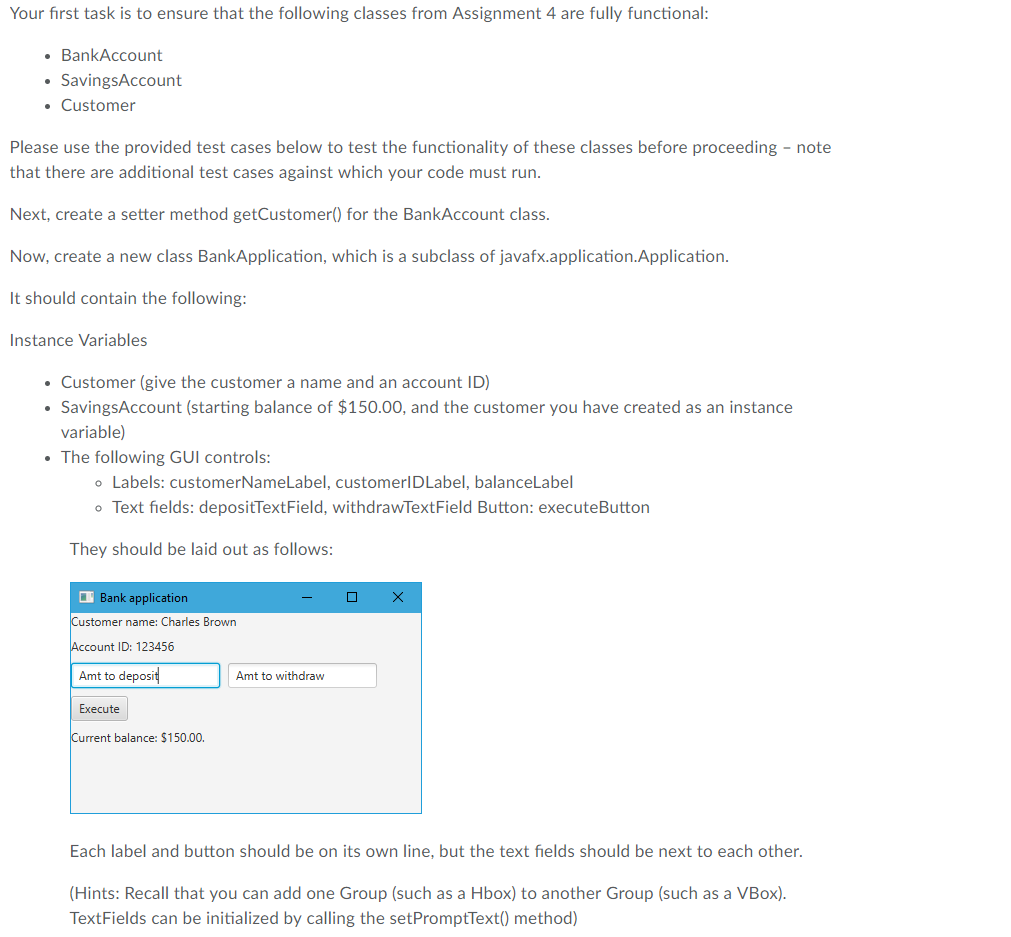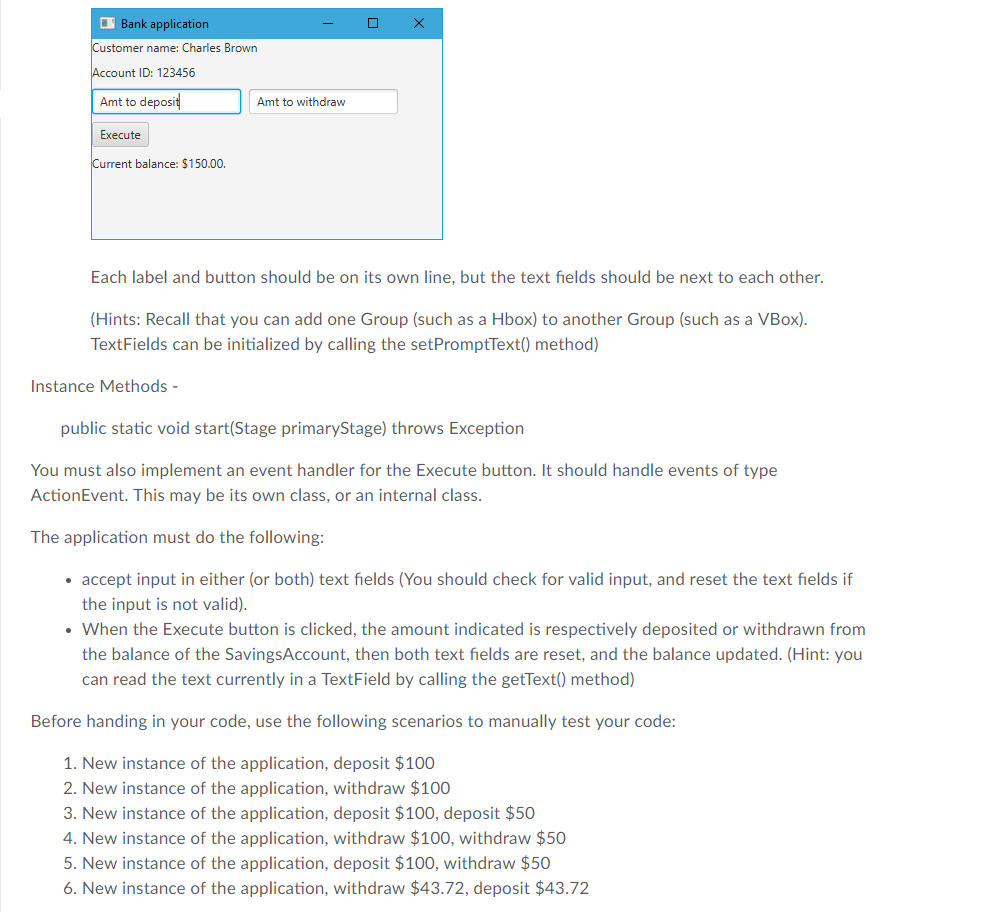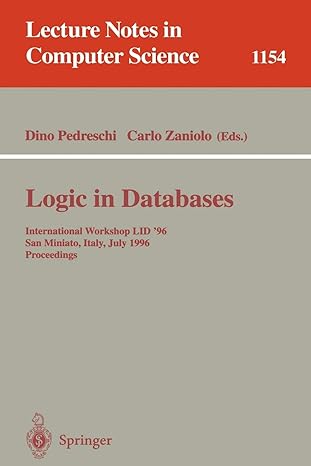Question
/** Define a new class SavingsAccount, which is a subclass of BankAccount. */ public class SavingsAccount extends BankAccount{ private double annualInterestRate; /** Using this method


/** Define a new class SavingsAccount, which is a subclass of BankAccount. */ public class SavingsAccount extends BankAccount{ private double annualInterestRate;
/** Using this method can access the annualInterestRate. @param none this method takes no argument @return one year deposit rate */ public double getAnnualInterestRate(){ return annualInterestRate; }
/** Using this method can update the annualInterestRate. @param newAnnualInterestRate a new one year deposit rate @return this method does not return anything */ public void setAnnualInterestRate(double newAnnualInterestRate){ if (newAnnualInterestRate >= 0.0) annualInterestRate = newAnnualInterestRate; }
/** When creating an new object,if no arguments provided, using this constructor to initialize it. @param none this method takes no argument @return this method does not return anything */ public SavingsAccount(){ super(); annualInterestRate = 0.0; }
/** When creating an new object,this constructor initializes the balance and annualInterestRate using the arguments @param balance balance the remaining in the account @param annualInterestRate one year deposit rate @return this method does not return anything */ public SavingsAccount(double initialBalance, double initialAnnualInterestRate){ super(initialBalance); annualInterestRate = initialAnnualInterestRate; } /** When creating an new object,this constructor initializes the balance and customer using the arguments @param customer a variable that represents the account owner, including information of name and ID @param balance the remaining in the account @return this method does not return anything */ public SavingsAccount(Customer initialCustomer, double initialBalance){ super(initialCustomer, initialBalance); } /** When creating an new object,if no arguments provided, using this constructor to initialize it. @param none this method takes no argument @return this method does not return anything */ public void depositMonthlyInterest(){ if (getBalance( ) > 0.0){ double interest = annualInterestRate/100.0/12*getBalance(); deposit (interest); } } }
-----------------------------------------------------------------------------------------------------------------------------------
/**
Class for customer data?name and customerID.
*/
public class Customer{
private String name;
private int customerID;
/**
Using this method can access the customer's name.
@param none this method takes no argument
@return name
*/
public String getName()
{
return name;
}
/**
Using this method can update the customer's name.
@param name a new name
@return this method doesn't return anything
*/
public void setName(String name)
{
this.name = new String(name);
}
/**
Using this method can access the customerID.
@param none this method takes no argument
@return customer's ID
*/
public int getID()
{
return customerID;
}
/**
Using this method can update the customerID.
@param id a new customer's ID
@return this method doesn't return anything
*/
public void setID(int id)
{
customerID =id;
}
/**
Using this method can get the information of name and customerID.
@param none this method takes no argument
@return the information of name and customerID
*/
public String toString()
{
return "name is " + name + ", customerID is " + customerID;
}
/**
When creating an new object,if no arguments provided, using this constructor to initialize it.
@param none this method takes no argument
@return this method doesn't return anything
*/
public Customer(){
name = "";
customerID = 0;
}
/**
When creating an new object,this constructor initializes the name and customer's ID using the arguments
@param name initializes name
@param id initializes customerID
@return this method doesn't return anything
*/
public Customer(String name, int id)
{
setName(name);
setID(id);
}
/**
When creating an new object,initializing name and customer's ID copying the data of other customer object
@param customer a variable that represents the account owner, including information of name and ID
@return this method doesn't return anything.
*/
public Customer(Customer otherCustomer)
{
name = new String(otherCustomer.name);
customerID = otherCustomer.customerID;
}
}
-----------------------------------------------------------------------------------------------------------------------------------
/**
create a class called BankAccount
*/
public class BankAccount{
private double balance, overdraftAmount = 100.0;
private Customer customer;
/**
using this method can add balance
@param amount amount of deposit
@return this method doesn't return anything
*/
public void deposit(double amount){
if (amount >= 0.0)
this.balance += amount;
}
/**
using this method can decrease balance
@param amount amount of withdraw
@return this method doesn't return anything
*/
public void withdraw(double amount){
if (this.balance - amount >= -overdraftAmount && amount >= 0.0)
this.balance -= amount;
}
/**
using this method can access balance
@param none this method takes no argument
@return balance
*/
public double getBalance(){
return this.balance;
}
/**
using this method can update overdraftAmount
@param amount amount of overdraftAmount
@return this method doesn't return anything
*/
public void setOverdraftAmount(double amount){
this.overdraftAmount = amount;
}
/**
using this method can access customer
@param none this method takes no argument
@return customer
*/
public Customer getCustomer(){
return customer;
}
/**
when creating an new object,this constructor initializes the balance and overdraftAmount
@param none this method takes no argument
@return this method doesn't return anything
*/
public BankAccount(){
balance = 0.0;
overdraftAmount = 100.0;
customer = new Customer();
}
/**
when creating an new object, this constructor initializes customer
@param initialCustomer initializes customer
@return this method doesn't return anything
*/
public BankAccount(Customer initialCustomer){
this.customer = new Customer(initialCustomer);
}
/**
when creating an new object, this constructor initializes customer and balance
@param initialCustomer intializes customer
@param initialbalance initializes balance
@return this method doesn't return anything
*/
public BankAccount(Customer initialCustomer, double initialbalance){
this.customer = new Customer(initialCustomer);
this.balance = initialbalance;
}
/**
when creating an new object, this constructor initializes balance
@param initialbalance initializes balance
@return this method doesn't return anything
*/
public BankAccount(double initialBalance){
customer = new Customer();
if (initialBalance >= 0.0)
balance = initialBalance;
}
}
Your first task is to ensure that the following classes from Assignment 4 are fully functional . BankAccount SavingsAccount . Customer Please use the provided test cases below to test the functionality of these classes before proceeding - note that there are additional test cases against which your code must run Next, create a setter method getCustomer) for the BankAccount class Now, create a new class BankApplication, which is a subclass of javafx.application.Application It should contain the following Instance Variables Customer (give the customer a name and an account ID) SavingsAccount (starting balance of $150.00, and the customer you have created as an instance variable) . The following GUI controls: o Labels: customerNameLabel, customerlDLabel, balanceLabel o Text fields: depositTextField, withdrawTextField Button: executeButton They should be laid out as follows Bank application ustomer name: Charles Brown count ID: 123456 Amt to deposit Execute urrent balance: $150.00. Amt to withdraw Each label and button should be on its own line, but the text fields should be next to each other Hints: Recall that you can add one Group (such as a Hbox) to another Group (such as a VBox) TextFields can be initialized by calling the setPromptText) method)
Step by Step Solution
There are 3 Steps involved in it
Step: 1

Get Instant Access to Expert-Tailored Solutions
See step-by-step solutions with expert insights and AI powered tools for academic success
Step: 2

Step: 3

Ace Your Homework with AI
Get the answers you need in no time with our AI-driven, step-by-step assistance
Get Started


